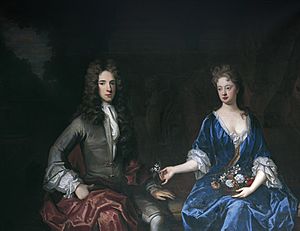Charles Eversfield facts for kids

Charles Eversfield (born 15 September 1683 – died 1749) lived at Denne Place, near Horsham, Sussex. He was a British politician who belonged to the Tory party. He served as a Member of Parliament (MP) in the British House of Commons for many years, from 1705 to 1747.
Contents
Early Life and Family
Charles Eversfield was the only son of Nicholas Eversfield and Elizabeth Gildridge. His father was from Charlton Court in Sussex. When Charles was very young, in 1684, he inherited his father's estates.
On 21 July 1702, Charles married Mary Duncombe. She was the daughter of Henry Duncombe from Weston, Surrey.
Charles Eversfield's Political Journey
In 1695, Charles Eversfield inherited the Denne estate from his uncle, Anthony Eversfield. This inheritance also gave him influence in elections for the area of Horsham.
As soon as he was old enough, Charles ran for election in Horsham in 1705. He won and was known as a 'Churchman'. He didn't stand out much in his first time in Parliament. However, he voted against the King's choice for Speaker on 25 October 1705.
He was elected again for Horsham in 1708 as a Tory. In 1709, he spoke out against the election of Thomas Meredyth for Midhurst. He also voted against the impeachment (a formal accusation of wrongdoing) of Dr Sacheverell in 1710.
In the 1710 election, he was chosen to represent both Horsham and Sussex. He decided to sit for Sussex. During this time, he was a spokesperson for a group called the October Club. In 1712, he got a job as the Paymaster and Treasurer of Ordnance. This meant he managed money for military supplies.
He was re-elected in 1713. But when King George I came to power in 1714, Charles lost his job as Paymaster.
Changes in His Career
In the 1715 election, Charles lost his seat in Sussex. He was also removed from his Horsham seat after a challenge on 16 June 1715. This left him without a place in Parliament.
Later, he made an agreement with his political rivals, the Ingrams. They agreed to share who would represent Horsham. Because of this, Charles was elected without opposition in a special election on 12 June 1721.
He was elected for Horsham again in 1722. At this point, he started supporting the government. He spoke in their favor during a debate about the army on 26 October 1722. He was re-elected for Horsham in 1727 and 1734. From then on, he regularly voted with the government. He also helped the Duke of Newcastle in county elections.
In 1737, he sold his properties in Horsham that gave him voting rights to the Ingrams. In 1741, he became an MP for Steyning. He continued to vote with the government. In 1746, he was considered an Old Whig. He did not run for election in 1747.
Later Life and Family
Charles Eversfield married a second time on 9 August 1731. His second wife was Henrietta Maria Lady Jenkinson. She was the widow of Sir Robert Jenkinson, 3rd Baronet and the daughter of Charles Scarborough.
Charles Eversfield passed away on 17 June 1749. He had one son and four daughters with his first wife. His eldest son, also named Charles, inherited a special title called a baronetcy.


